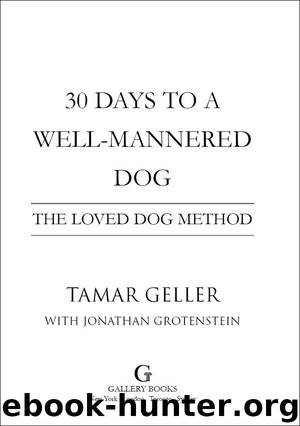30 Days to a Well-Mannered Dog by Tamar Geller & Jonathan Grotenstein

Author:Tamar Geller & Jonathan Grotenstein
Language: eng
Format: epub
Publisher: Gallery Books
Published: 2010-07-15T00:00:00+00:00
BODY LANGUAGE
We’ve spent a lot of time so far talking about the best way to teach your dog. But what has your dog taught you? It’s time to learn to listen to our dogs a bit more deeply.
As we said earlier, dogs are somewhat limited in their vocal communication. There are a few different kinds of barks, growls, and other sounds, but they’re not always easy to tell apart. On the other hand, dogs are extremely expressive in their non verbal communication.
Have you seen your dog smile? Most dogs use several different kinds of smiles. The two most common are the submissive smile—a dog reveals his front teeth, but keeps the back ones hidden—and the happy and relaxed smile—no teeth at all. Your dog may stamp his front two paws when he wants to get your attention or tilt his head when he’s curious, focused, or trying to figure out something you’ve said. His ears point forward when he’s alert, backward and flat when he’s nervous or submissive. Dogs bow toward one another when they want to play.
How does your dog use his tail? Fast wags often mean a dog is excited, while slow wags can be an indication that he’s uncertain about something that’s going on around him. A tail pointing stiffly upward means confidence (some might even call it arrogance!). Straight up and moving stiffly is often a sign of potential aggression. Dogs who are afraid will let their tails hang low, sometimes tucking them between their legs to cover their “business cards,” the anal glands that advertise their special scent. When the tail straightens horizontally, your dog probably sees something interesting. Some hunting breeds or mixes may even lift one of their front legs, just like you see in photos from the old days of hunting foxes or birds.
When read in combination, these gestures can give you a sense of your dog’s overall mood. For example, a dog who is stressed out may drool, yawn, lick his lips, and close or otherwise avert his eyes. A good, full-body shake usually means that he’s released his stress, something you’ll often see after he’s met a new person or dog.
How else does your dog talk to you? Does he scratch at or pounce on objects he wants to play with? Does he lick his lips when he’s hungry and no food is nearby? Your dog may not be able to speak, but he’s always communicating. It’s up to us to learn how to listen—being a good listener is the most important tool in building a good relationship.
A dog who is wagging his tail isn’t necessarily friendly and may not want you to pet him. It’s important to read a dog’s body language correctly, particularly when kids are interacting with a new dog for the first time.
Download
This site does not store any files on its server. We only index and link to content provided by other sites. Please contact the content providers to delete copyright contents if any and email us, we'll remove relevant links or contents immediately.
| Breeds | Care & Health |
| Training |
Finding Gobi by Dion Leonard(2781)
Grumpy Cat by Grumpy Cat(2686)
A New Earth: Awakening to Your Life's Purpose by Eckhart Tolle(2596)
The Silkworm by Robert Galbraith(2443)
Tippi by Tippi Hedren(2182)
End of Days by Sylvia Browne(2116)
Total Cat Mojo by Jackson Galaxy(1968)
Backyard Chickens Beyond the Basics by Pam Freeman(1905)
The Animals Among Us by John Bradshaw(1831)
The Ultimate Pet Health Guide by Gary Richter(1728)
All Things Bright and Beautiful by James Herriot(1709)
Vet in Harness by James Herriot(1664)
Doggy Desserts: 125 Homemade Treats for Happy, Healthy Dogs by Cheryl Gianfrancesco(1653)
Dog Years by Mark Doty(1643)
Cesar's Way by Cesar Millan(1633)
Chicken Soup for the Ocean Lover's Soul by Jack Canfield(1602)
Dog Training 101 by Kyra Sundance(1557)
Walking with Peety by Eric O'Grey(1554)
Animal Speak by Ted Andrews(1514)
